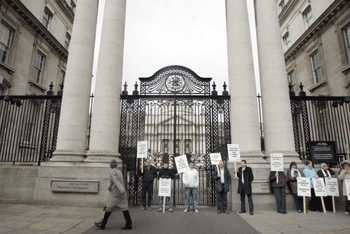Budget must tackle spending

With tax avenues exhausted to the point where returns are increasingly diminishing, there’s no choice but to start cutting where it hurts
16 November 2009
With November’s income tax payments from the self-employed set to come in well under target, the fiscal crisis facing the Government as it attempts to draw up next month’s budget has gotten even worse. With tax increases depressing rather than increasing revenues, there is no way that Brian Lenihan and his colleagues can avoid imposing swingeing spending cuts on 9 December.
The October exchequer returns, which contained details of what the Government collected in taxes, said it all. In of spite increasing taxes by an annualised €6 billion in the October 2008 and April 2009 budgets, the €26 billion which the government raised in taxes for the first 10 months of the year was €5.4 billion lower than for the first 10 months of 2008.
Not alone are tax revenues running 17% behind 2008 they are also about €1 billion short of the (much reduced) targets published in the April 2009 budget. This year the government will be lucky to collect €32 billion in tax, compared to the €34.4 billion target announced last April.
This collapse in tax revenues means that the government is going to have to borrow almost €25 billion to fund its activities this year. Throw in the cost of recapitalising the banks and NAMA and the national debt, which has already almost doubled to €73 billion over the past 22 months and is on track to double yet again over the next two years.
You can run but you can’t hide
While some of this debt, primarily the €54 billion cost of NAMA and the €11 billion, so far, which has gone towards recapitalising the banks, can be kept “off balance sheet” and doesn’t count when the EU is calculating our budget deficit and national debt as a percentage of GDP, no-one is fooled by such fiscal sleight of hand.
This point was reinforced when rating agency Fitch cut Ireland’s credit rating by two further notches at the beginning of this month. Announcing the downgrade, Fitch specifically mentioned the cost of NAMA as one of the reasons for its decision. Off balance sheet how are you!
So with tax increases having passed the point of diminishing returns, with 250,000 southerners doing their shopping in Northern Ireland, and almost one-third of all cigarettes being smoked in this country either smuggled or counterfeit, the Government has no choice but to cut spending, no matter how politically painful such cuts turn out to be.
The elephant in the room
Of the €58 billion which the government expects to spend this year, almost 75% will go on public sector pay and social welfare. This means that any meaningful reduction in public expenditure will involve cuts in the public sector payroll and numbers and in social welfare rates.
The case for cuts in public sector pay and numbers is unanswerable. When the 1999 Eircom and 2006 Aer Lingus privatisations are stripped out, underlying public sector numbers have risen by 94,000 to 370,000 since 1997; an increase of 34%. Is Ireland 34% better governed due to all of these extra public sector staff? I very much doubt it.
At the same time there is now irrefutable evidence that public sector workers are much, much better paid than their private sector counterparts, and that’s before any value is placed on their bullet-proof public sector pensions. The most recent survey of public sector pay levels by the ESRI concluded that, when the higher education levels of public sector workers and the larger proportion of them who hold supervisory positions (too many chiefs and not enough Indians perhaps) are taken into account, average public sector pay is 26 % higher than in the private sector.
Meanwhile the CSO’s most recent National Employment Survey calculated that average hourly pay rates in the public sector are 47% higher than in the private sector.
With public sector pay and pensions now costing €20 billion per year, major cuts in both public sector pay and numbers are inevitable. Forget the guff about “protecting front-line services” spouted by the public service trade unions and their political and media dupes. All of the comparative evidence indicates that, not alone are public sector workers extremely well paid by Irish standards, they are also very well paid when compared to similar staff in other countries.
The €350,000 a year which was pulled down by former Central Bank governor John Hurley, the man who presided over the destruction of the Irish banking system, is more than either ECB boss Jean-Claude Trichet or Fed chairman Ben Bernanke is paid, while Brian Cowen’s annual €280,000 wedge almost matches that of Barack Obama.
It’s the same story with hospital consultants whose €245,000 basic contract is more than twice that received by their counterparts in the UK, and that’s not counting what they pull in from private patients. Other categories of public sector workers including guards, nurses and teachers also do much better in this country than elsewhere.
Our social welfare rates are also way out of line with those paid in other countries. The basic weekly social welfare payment in this country is €204 per week for a single person and €338 for a couple. In the UK, the comparable rates are £64 and £100 respectively. With social welfare now costing €23 billion a year, this is not a tenable situation.
Any budget which doesn’t address these anomalies won’t be worthy of the name.
Delusional
In a globalised economy with free movement of capital and labour, the notion that we can pay public sector workers and social welfare recipients a multiple of what is paid in competitor countries is delusional. Particularly when the money which is being used to pay these extravagant salaries and welfare rates is borrowed.
With the government likely to take in just 59c in taxes for every euro it spends this year, things can’t go on like this. Brian Lenihan’s first two budgets skirted around the main problem in the public finances, excessive spending, and preferring instead to load the burden of fiscal adjustment on to taxpayers.
That’s no longer an option. With taxpayers having already signalled that they have had enough and the rating agencies making it clear that the willingness of foreign investors to buy our bonds is strictly limited, spending cuts are now the only route back to national solvency, no matter what the public sector trade unions think.



 Print
Print






Fans 0
Followers